
Baking cakes and other treats can be more complicated than it looks, because of the sheer number of factors that contribute to success. Your ingredients have to be fresh and properly measured, you have to handle them correctly and even outside factors such as the weather conditions can have an effect. Knowing how to adapt to these variables is one trait that distinguishes a skilled baker from a novice.
Rainy Day Cakes
Video of the Day
There isn't always a direct correlation between the weather outdoors and the success of your baking, but when it occurs it can be maddening. Your cake will rise vigorously in the oven, but will suddenly collapse either late in the baking time or shortly after you've taken it from the oven to cool. You'll be left with a cake that's perfectly baked around the edges, but fallen and dense in the middle. Some bakers try to compensate by ensuring that their ingredients are perfectly dry. Unfortunately that effort is wasted, because the problem is not caused by the rain's moisture but by the weather system itself.
Video of the Day
Air Pressure and Baking
Most bakers are aware that cakes and baked goods behave differently when you bake at higher altitudes. That's partially because the air at high elevations is dry, but mostly because the air pressure is lower. The thin air offers less resistance to the cake's expansion as it bakes and, as a result, cakes tend to over-rise and then fall. At lower altitudes, the arrival of rainy weather is usually the result of a low-pressure zone. That means the barometric pressure in your area plunges sharply, creating a temporary effect similar to the effect of high altitude.
Adapting Your Ingredients
If you live at or near sea level it might seem strange to use high-altitude baking strategies, but it's the most effective way to counter variations in your cake baking caused by low-pressure storm systems. The simplest adjustment is to reduce the amount of leavening in your recipe. Try scaling back your baking soda by 1/4 teaspoon, or baking powder by a half-teaspoon. You can also strengthen the cake batter by adding two or three tablespoons of flour, or half a beaten egg white, to the mixture. The added protein helps the batter trap the gas from the leavening, rather than letting it escape, leaving behind a deflated cake.
Adapting Your Technique
Aside from tweaking the ingredients in your batter, you can adjust your cake-mixing technique. If you're making a sponge cake or angel food cake that relies on beaten-in air, beat the egg whites a bit less. This reduces the cake's rise, and limits the likelihood of it collapsing afterward. If you're making a cake that creams the fat and sugar, cut the creaming time by 1/2 to 1/3. That also reduces the amount of air in your batter, and limits the rise. Finally, try increasing your baking temperature by 10 to 15 degrees Fahrenheit. That will help the batter set firmly before the gases can escape, and keep it from collapsing.